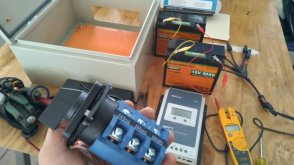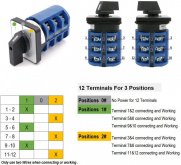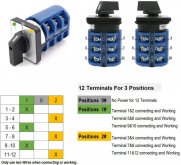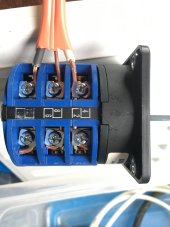offgriddle
"FOREVER BEGINNING"
Ok, I purchased this three phase BAOMAIN, SW26-63/D303.3 cam switch switch in hopes that I could use it as a simple two pole transfer switch to supply 110VAC to a tiny off grid home by switching between generator power OR inverter power.
I tried "ohming it out" with my volt ohm meter so I could make a terminal connection diagram, but the only terminals that show continuity are 1 and 2.
There was no documentation provided and I looked online for diagrams and found nothing and looked on YouTube for instructional videos but found no videos posted in coherent English.
Note: I noticed a slight burnt smell from the switch but it in every other way appears to be new and never used out of the box.
Any Ideas?
OG
 T
T
I tried "ohming it out" with my volt ohm meter so I could make a terminal connection diagram, but the only terminals that show continuity are 1 and 2.
There was no documentation provided and I looked online for diagrams and found nothing and looked on YouTube for instructional videos but found no videos posted in coherent English.
Note: I noticed a slight burnt smell from the switch but it in every other way appears to be new and never used out of the box.
Any Ideas?
OG
 T
T





